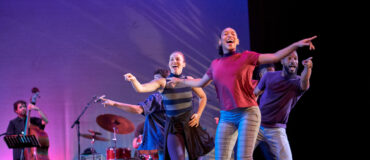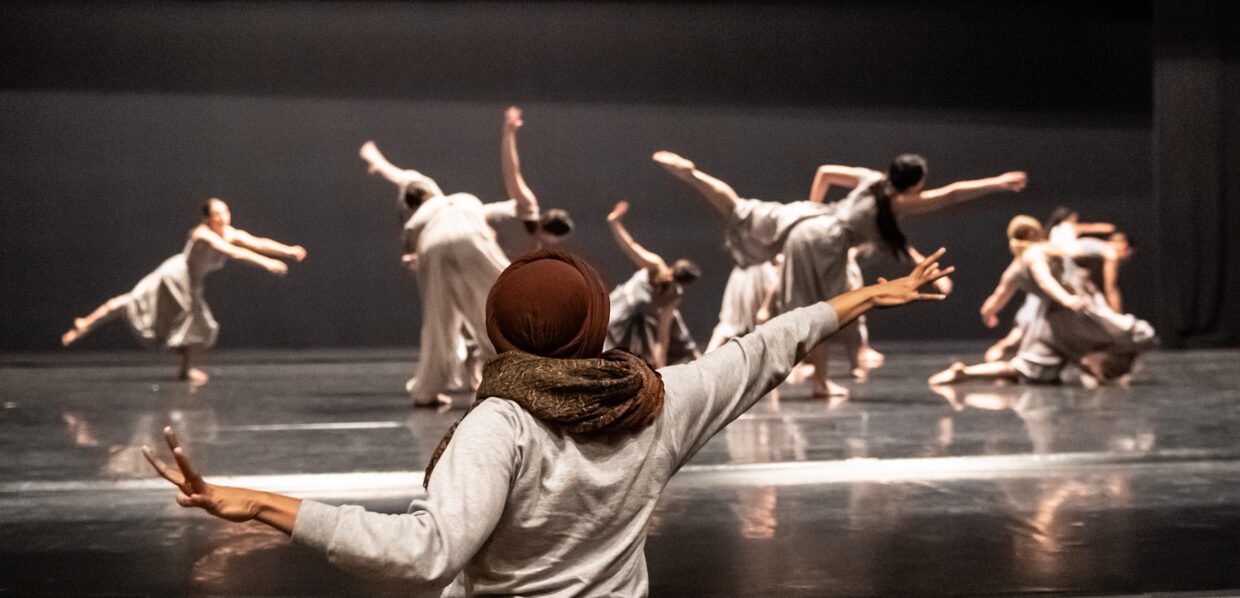By Bethany Greenho
Bethany Greenho is a 2023 Archiving and Preservation Fellow with Cleo Parker Robinson Dance. Read more about the Fellowships here. This is the second part of Bethany’s blog; read the first part here and the third part here.
Archives Outside the Classroom
Over the last two years, I heard from many librarians and archivists who were guest speakers in my Library and Information Science courses about how my fellow classmates and I were going to quickly realize that some of the theory we were learning in the classroom would need to be modified in our actual work. After roughly one month of working on an inventory of Cleo Parker Robinson Dance’s (CPRD) archival materials, I have come to appreciate their point.
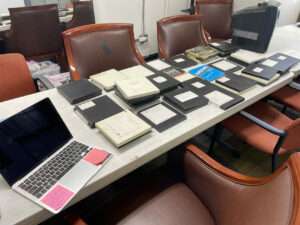
Table with cases of 1/4” open reel tapes of Cleo Parker Robinson Dance Ensemble repertoire music from the Cleo Parker Robinson Dance Archive being inventoried.
This is not to say that the archival principles, theories, and standards I learned in the classroom are completely non-existent in the work I have been doing. Archival theory and standards informed the beginning of my work on the inventory. I started with Dance/USA’s Artist’s Legacy Toolkit Inventory Template and the Dublin Core metadata schema, a set of fifteen different information categories that are commonly used to describe materials in various library and archives institutions, to establish the types of information, or fields, to include and collect in the inventory. I used Dublin Core-recommended terms as well as the Library of Congress Genre/Form Terms for Library and Archival Materials (LCGFT), a nationally recognized list of terms that describe the nature of what an item is, and even Describing Archives: A Content Standard, a nationally recognized standard for how archival collections and content are described, to establish lists of terms, or controlled vocabularies, to use in different fields and how those terms should be formatted. I even looked at the finding aids, documents created by archivists to describe archival collections’ creators, context, contents, and location, for other Black dance artists and organizations to see how other archival institutions were talking about materials similar to those in CPRD’s collection. Taking my lead from these different resources, I generated an initial inventory schema that seemed to fit with archival standards and practices.
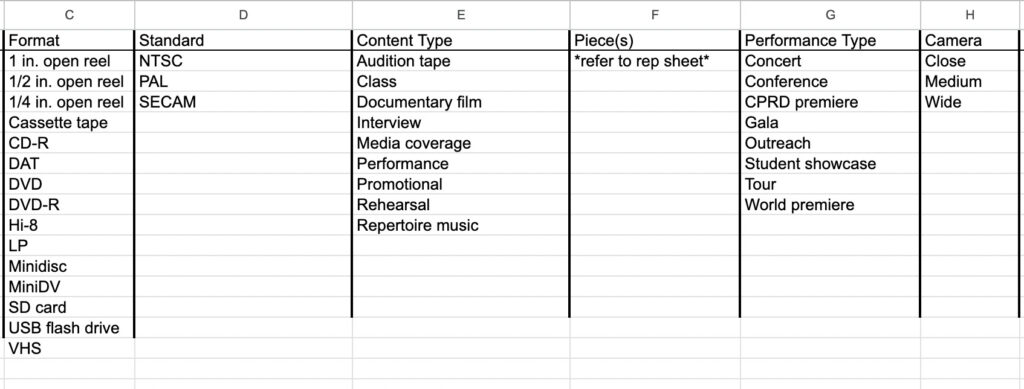
Screenshot of some of the term lists being used to describe AV materials in the Cleo Parker Robinson Dance Archive.
But while I was looking at these resources, I was also reviewing the basic overview of collection materials I generated in my first couple of weeks and talking to different staff members. Reviewing the basic inventory allowed me to find common terms that CPRD staff members used to describe similar groups of materials. Even if these terms did not show up in the LCGFT or Dublin Core-recommended term lists, I added them in my own list of terms. Similarly, asking staff members questions such as “How would you categorize this item?” or “Is item x similar to item y? And if not, how would you describe the difference between the two?” have provided a more nuanced look at the operations and work of CPRD that I can then incorporate into the different terms used in the inventory. Additionally, talks with staff members have helped me figure out what types of information are pertinent in the organization. For example, knowing that Cleo Parker Robinson and the Ensemble continue to use archival footage to stage repertoire meant it was important for Cleo and the dancers to know if video footage was filmed including close or wide shots. This conversation led to the addition of a new field to the inventory. Similarly, I learned that CPRD differentiates between the kinds of performances the Ensemble does, such as biannual concerts, tours, lecture demonstrations, and collaborations, and that Cleo likes to know if a performance was a world or CPRD premiere. This information meant my initial field for “Content” of an item was too narrow. Again, I added a new field of “Performance Type” to include the organization’s specificity. The staff’s input, therefore, changed the inventory. While the inventory still retains many of the archival standards and practices I started with, making this inventory and the information it records more oriented towards CPRD’s staff and their needs and functions begins to inch the inventory away from archival standards’ collection-focused approach towards a more user-centered approach.
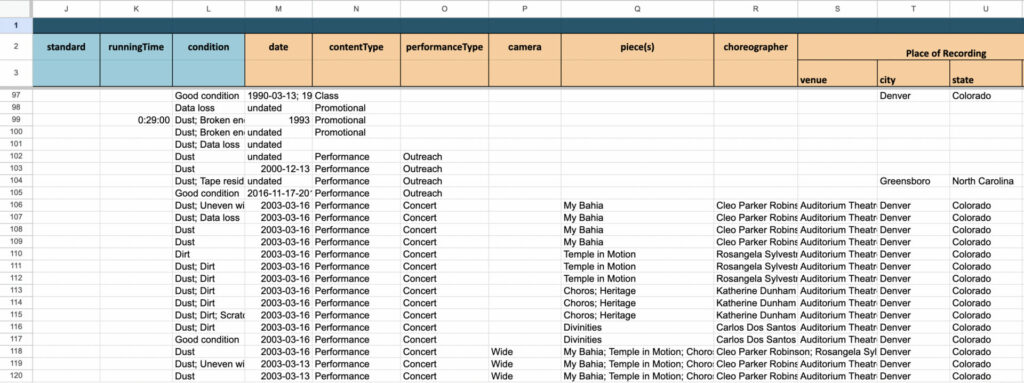
Screenshot of a portion of the Cleo Parker Robinson Dance Archive AV inventory sheet, which include some of the fields added after conversations with CPRD staff members.
While the inventory is moving away from archival standards and practice, the scope of the collection is where I have seen the most push back against traditional archival practice. During my initial examination of materials, I noticed that there were quite a few published or secondary source materials mixed in with Cleo’s handwritten notes or production materials. Additionally, there were materials more directly related to Cleo’s mentors and collaborators rather than Cleo or CPRD. My brain immediately went back to my coursework, thinking that because these were published materials and not unique to or directly about Cleo or CPRD, these materials would not have “archival” value and could be flagged for exclusion from the archive. However, in my initial conversation with Cleo I learned two things. First, her choreographic process includes reading and watching as much as she can to explore a particular culture, event, or individual that might inspire a piece. Second, Cleo’s work and the philosophy of CPRD are based in collaboration and building on the work of the activists, ancestors, and artists that came before. From this conversation I knew that I was going to have to rethink my understanding of what “archival” value meant to Cleo and CPRD. So, rather than flag materials for removal, I started flagging them to ask about the use, significance, and background story of materials to determine if an item has “archival” value. And who better to unpack whether items have significance to the story of Cleo and CPRD than Cleo herself? In shifting my focus from following archival theory and standards to determining what gets kept in the archive, I have been able to work directly with Cleo to ensure that the stories, collaborations, and contexts that otherwise might be removed in the name of archival science remain intact and her voice is directly included in the archive.
Header image: photo by Jerry Metellus, courtesy of Cleo Parker Robinson Dance Ensemble.
All other images courtesy of the author.
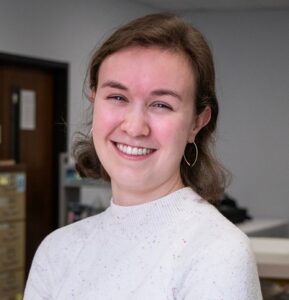 Bethany Greenho (she/her) is finishing a master’s degree in library and information science with a focus in archives and digital curation at the University of Maryland, College Park. She is interested in discovering how user-oriented access and ethical and community-centered description can become the means through which hidden or ignored stories become findable and accessible.
Bethany Greenho (she/her) is finishing a master’s degree in library and information science with a focus in archives and digital curation at the University of Maryland, College Park. She is interested in discovering how user-oriented access and ethical and community-centered description can become the means through which hidden or ignored stories become findable and accessible.
Bethany’s work with the George Balanchine Trust showed her the importance of having access to the tangible artifacts of dance as a way to preserve dance and its history beyond its ephemeral nature. In her current work with the University of Maryland Libraries Preservation Department, Bethany has seen how preservation works in concert with archives to ensure continued access to all stories.
Bethany is excited to use her background in dance and archival science at the Cleo Parker Robinson Dance Company to begin the process of organizing and preserving their collections to make them accessible to the community. Photo courtesy of Bethany Greenho.
____
We accept submissions on topics relevant to the field: advocacy, artistic issues, arts policy, community building, development, employment, engagement, touring, and other topics that deal with the business of dance. We cannot publish criticism, single-company season announcements, and single-company or single artist profiles. Additionally, we welcome feedback on articles. If you have a topic that you would like to see addressed or feedback, please contact communications@danceusa.org.
Disclaimer: Opinions expressed in guest posts do not necessarily represent the viewpoints of Dance/USA.


